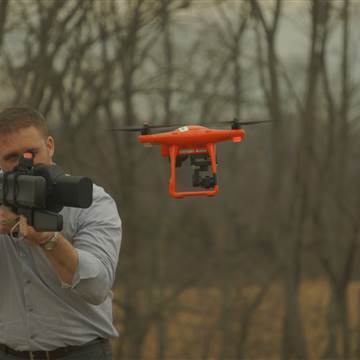As millions gather in Washington, D.C. for the inauguration of President-elect Donald Trump, there’s a new threat facing the Secret Service: airborne drones.
Despite being one of the most popular Christmas gifts in years, a drone in the wrong hands can be deadly.
“Drones are prohibited in the airspace over Washington, D.C.,” says Jeh Johnson, secretary of Homeland Security. “This is something we have thought about, we have planned for, and there is technology to deal with it.”
Related: Life Saving Drones Promise Revolution in Emergency Care
When asked about that defensive technology, Johnson says it’s a secret.
What’s not a secret are the real world threats.
In October, an ISIS drone strapped with a bomb exploded in Mosul, Iraq, killing two Peshmerga soldiers and leaving two French soldiers wounded. U.S. special forces now call these armed drones “flying IEDs,” or improvised explosive devices.
The U.S. Military’s Central Command says coalition forces are seeing adversarial drones on an almost daily basis. It’s why security experts in D.C. are paying extra close attention this Friday as large crowds gather outdoors at the inauguration.
Drones, small and manufactured mostly of plastic, are often invisible to radars.
Related: Protecting Your Internet Presence in the Age of Trump
Experts are finding that spotting a tiny drone flying at speeds up to 100-miles-per-hour and then deploying a response from the ground can be challenging. Traditional radars don’t work well because that old-school technology also picks up birds and planes, which can look like drones.
In 2015, a Japanese protester strapped nuclear waste to a drone and flew it undetected to the prime minister’s residence.
“It’s a real threat,” says former CIA targeting officer Josh Desmond. “If you look at what’s going on overseas in the Middle East, it’s a proven threat, not a theoretical one.”
“If you look at what’s going on overseas in the Middle East, it’s a proven threat, not a theoretical one.”
While Homeland Security won’t detail what technology the Secret Service is using, there are hints from companies developing their own countermeasures.
Desmond, now vice president of business development at DroneShield, says his company has “high-tech listening” technology to eliminate false alarms, and that can detect and then take control of an incoming enemy drone.
DroneShield uses an array of parabolic microphones to listen for the telltale signature of the machine’s rotor blades. The system has been deployed the last two years at the Boston Marathon.
“A lot of sounds you think of are a lot lower frequency than these drones,” says John Franklin, DroneShield’s chief scientist. “What goes into telling them apart is both the frequencies they’re emitting noise at and also how that’s changing over time.”
Once a drone is spotted, a ground agent fires a DroneShield gun at the perceived threat. The gun doesn’t shoot ammunition, rather it fires radio waves that disrupt communication between the drone and its pilot, effectively eliminating contact with the potential terrorist, who could be up to a mile away.
The ground agent can then safely guide the drone back to earth.


But jamming signals in the U.S. requires Federal Communications Commission approval, so while the “ray-gun” has been used successfully in Australia and Turkey, in the U.S. jamming is restricted to the Secret Service and the military.
Desmond says he understands why. A jamming signal fired off course could hit a plane, or a cellphone tower, or maybe even a drone that is simply being flown by a hobbyist.
“You’re talking about collateral damage and liability if you’re shooting it out of the sky,” Desmond says. “It’s hard to hard to distinguish between recreational use and somebody that’s attached something that shouldn’t be on a drone. ”
Related: Could One Person Take Down the Internet?
Another company, Department 13, tracks and detects potential threats by “sniffing” the airwaves for drone WIFI and GPS signals.
Once the drone is detected, Department 13 computers fire off signals that hack into the drone, giving the good guys control.
“We want to change the flight plan and tell it to fly somewhere else,” says Robi Sen, Department 13 founder. “By the time you visually see it, it may be too late.”


![[MWC 2025] Samsung’s Mobile Technology Leadership Shines](https://loginby.com/itnews/wp-content/uploads/2025/03/1741515476_MWC-2025-Samsung’s-Mobile-Technology-Leadership-Shines-238x178.jpg)




